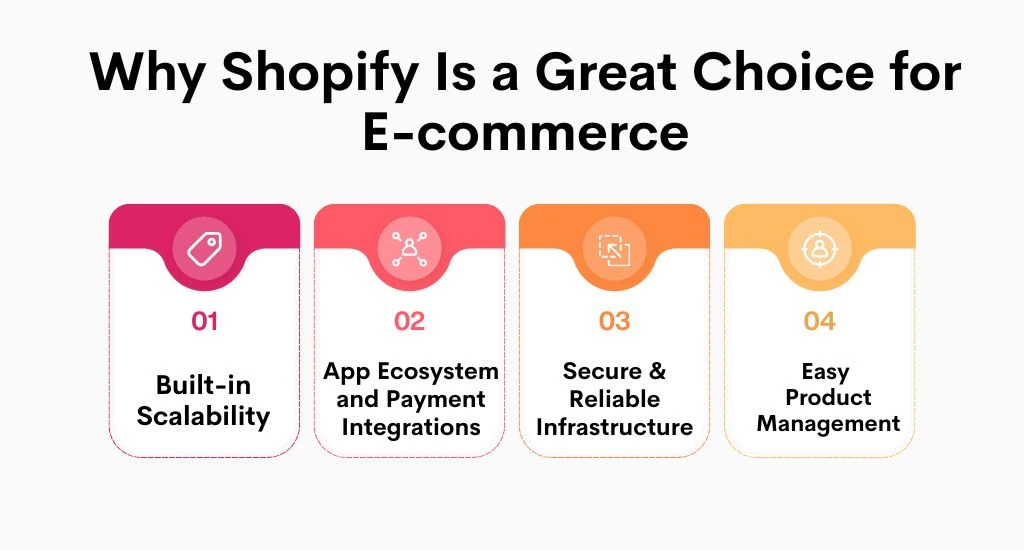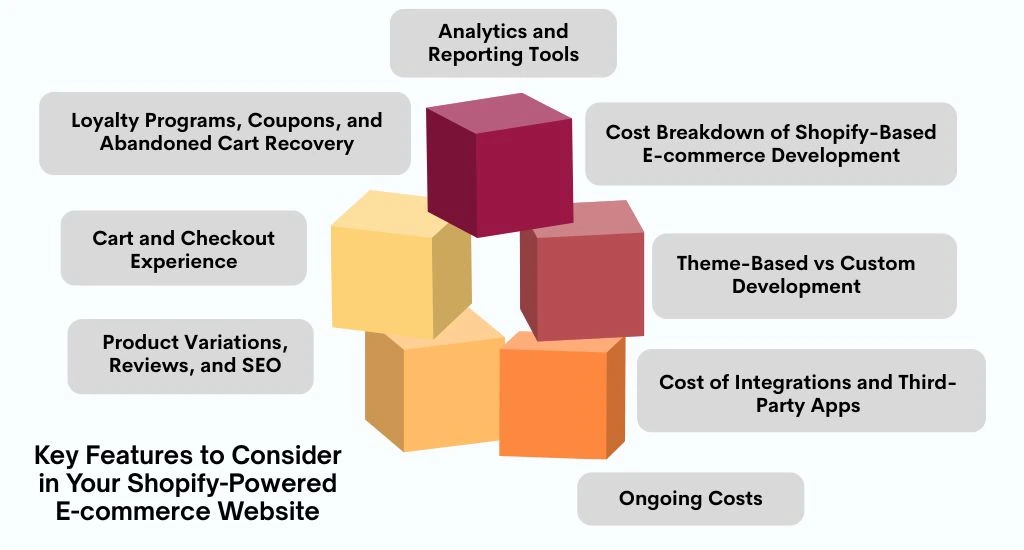|
Getting your Trinity Audio player ready...
|
In a digitally dynamic environment, where one can even set up shop without being in a physical space, Shopify has truly developed into the cornerstone of contemporary e-commerce success. From its original use as a medium for the online sale of snowboards, it has transformed into a multi-billion dollar platform powering businesses, from basement startups to those listed under the Fortune 500.
With Shopify, the non-tech savvy person can open an online store. It is a platform that makes it easy for anyone to start an enterprise without extreme customisation, as it allows for broad application programming interfaces that are very quickly integrated into what will likely become the new standard for rapid expansion and scalability.
Who is This Guide For?
This guide is specifically directed to:
- Startups and Entrepreneurs out to rapidly market their businesses without incurring enormous budget expenditure on development.
- D2C (Direct to Consumer) Brands that want to manage their customer journey.
- There are established retailers who want to extend their brick-and-mortar commerce into digital space.
- Agencies and Technical Teams that manage integration or are looking for headless architectures in Shopify for clients.
What’s in Store
This guide comprehensively walks you through:
- What makes Shopify stand out from the rest of the crowd in e-commerce?
- These are the main steps in creating a Shopify-based site.
- Integration methods from simple to headless commerce.
- Core features of growth and user experience.
- Real cost breakdown.
Why Esferasoft?
The Go-to Partner for Shopify eCommerce Development.
At the end: You then understand how to build and scale your online store with Shopify as a basis.
Why Shopify Is a Great Choice for E-commerce

Built-in Scalability
Shopify grows with you. Whether you’re processing ten orders a day or ten thousand during a Black Friday rush, Shopify’s cloud-based architecture ensures speedy access for anyone at any time. Add to that the sophisticated capabilities that Shopify Plus bestows upon high-growth brands, including advanced support, automation tools, and detailed analytics.
Easy Product Management
Managing inventory is hassle-free. You can set up quite complex catalogues quickly through bulk-import tools, SKUs, variant options, and custom tags. Adding images, descriptions, metadata for SEO, and attributes would take minutes instead of hours.
Secure & Reliable Infrastructure
Security is vital for consumer trust. Shopify ensures:
- PCI DSS Level 1 compliance (mandatory for processing credit cards).
- Free SSL certificates for encrypted browsing.
- Built-in fraud analysis tools.
- Regular automated backups and version history.
This allows you to focus on growing your business, not on keeping uptime or wrestling with security threats.
App Ecosystem and Payment Integrations
Shopify’s App Store is bursting with over 8,000 integrations to handle everything from email marketing to dropshipping. If you want it, there’s an app for it, whether it’s upsell apps, loyalty accounting tools, or live chat support.
And on the payment end, Shopify integrates with over 100 gateways, including:
- Shopify Payments (with zero transaction fees)
- PayPal, Stripe, and Apple Pay
- Local ones like Razorpay, Klarna, iDEAL, and so on.
Do you need help choosing apps and payment tools? [Talk to our Shopify experts].
What Does E-commerce Website Development with Shopify Involve?
Domain, Hosting, and Theme Setup
Shopify simplifies this traditionally complex step. Hosting is built-in with enterprise-grade speed and security. You can register a domain through Shopify or connect your existing one.
Themes act as the blueprint for your store’s look and feel. You can start with a free theme like Dawn or invest in premium themes like Prestige or Impulse.
Product Catalog Design
A well-designed product catalogue is vital. Best practices include:
- High-resolution images (multiple angles, zoom-enabled).
- Detailed descriptions using storytelling and SEO keywords.
- Tag-based categorisation allows easy filtration.
- Custom fields are for technical specs, reviews, and FAQs.
This section of Shopify website development requires both creative and technical input to ensure optimal UX and SEO.
Navigation and Filtering Structure
The success of your site hinges on how easy it is to navigate. Navigation should be intuitive with:
- Mega menus for categories and subcategories.
- Breadcrumbs to help users track their browsing path.
- Faceted filters are available in sizes, colours, prices, and more.
- Smart search with predictive text and spell check.
Customising this part of Shopify requires coding expertise in Liquid, Shopify’s templating language.
Payment Gateway & Shipping Setup
Key steps include:
- Connecting your preferred gateway(s).
- Setting shipping zones, methods, and real-time rates.
- Enabling shipping labels and tracking.
- Integrating with logistics partners (FedEx, UPS, Shiprocket, etc.).
You can also offer local delivery, in-store pickup, and even subscription billing via apps like Recharge.
Custom Feature Implementation
Unique business models need tailored features. Examples include:
- Product builders (e.g., custom T-shirt designs)
- Subscription/membership systems
- Wholesale portals with tiered pricing
- Booking or reservation tools
- B2B quote engines
Need help implementing a complex feature? [Schedule a free consultation].
Shopify Integration Options
Shopify Store with Standard Themes (Plug & Play)
These themes are ideal for small businesses or MVP launches:
- Are responsive across all devices.
- Support essential Shopify features immediately.
- Can be lightly customised via the theme editor.
- Require minimal technical knowledge.
Limitations include decreased design flexibility and limited UX customisation.
Custom Shopify Themes (for Branding & UX)
A custom theme enables:
- Brand-first design
- Mobile-optimized layouts
- Conversion-focused UI
- Integration of animations, micro-interactions, and A/B tested elements
Built using Liquid, HTML/CSS, and JavaScript, this option is best for brands serious about differentiation.
Headless Shopify Integrations
Headless commerce involves separating Shopify’s backend from the frontend. Frontends can be built using:
- React (Next.js)
- Vue (Nuxt.js)
- Svelte, Angular, or Gatsby
Benefits include:
- Lightning-fast load times
- Control over SEO, accessibility, and design
- Omnichannel experiences (e.g., apps, kiosks, AR/VR interfaces)
Shopify’s Shopfront API powers dynamic content delivery, giving developers full flexibility.
Integration with CRMs, ERPs, and Inventory Systems
For larger operations, automation and syncing are key. Common integrations include:
- CRMs: HubSpot, Salesforce
- ERPs: SAP, Oracle NetSuite
- Inventory tools: Skubana, TradeGecko
- Accounting tools: QuickBooks, Xero
These often require custom middleware or APIs to ensure data consistency and real-time syncing.
Want to connect Shopify to your internal systems? [Get an integration audit].
Key Features to Consider in Your Shopify-Powered E-commerce Website

Product Variations, Reviews, and SEO
Maximising engagement with:
- Colour, sizes, and custom field options.
- Shopify – the technical data’s keeper.
- Star ratings and image testimonials.
- SEO-friendly URLs, meta titles, alt tags, and schema.
Cart and Checkout Experience
Cart abandonment means losing conversion. Make checkout more efficient by:
- Providing a guest checkout
- One-page checkout
- Real-time shipping calculation
- Trust badge and payment icons
Apps such as Bold Upsell and Honeycomb could also help increase average order value (AOV).
This includes Loyalty Programs, Coupons, and Abandoned Cart Recovery
Retention is all about the keeping of customers.
Use:
- Loyalty apps: Smile.io, Yotpo.
- Exit-intent popups and email flows.
- Dynamic discounts: for holidays, referrals, and VIP tiers.
This includes the analytics and reporting tools
- Data drives growth. Shopify reports include:
- Product performance
- Conversion funnel insights
Customer LTV and cohort analysis
- Further tracking could be connected to
- Google Analytics 4
- Hotjar (heatmaps)
- Klaviyo (email performance)
- Facebook & TikTok pixels
Does choosing which metrics to monitor ever feel confusing? up your analytics stack].
Cost Breakdown of Shopify-Based E-commerce Development
- Theme-Based vs Custom Development
- Basic store setup with theme: $2,000-5,000
- Custom-designed Shopify site: $8,000-25,000+
- Headless commerce builds: $25,000-100,000+
The more customisations you need, the bigger your initial investment will be.
Cost of Integrations and Third-Party Apps
- Apps: $20-300/month depending on features
- Custom integrations (CRM/ERP): $2,500-15,000+
- Third-party plugins: Could also include licensing fees or API fees
Ongoing Costs
- Shopify Plan: $39-2000/month (Basic to Plus)
- App Maintainability: Variable
- Maintenance & Support: $500-2000/month
- Marketing Budget: Based on Ad spend & Strategy
Do you require a comprehensive cost estimate? [Get a custom proposal catering to your brand].
Why Choose Esferasoft for Shopify Ecommerce Development?
We are not just developers of Shopify; instead, we partner with businesses to grow. So far, Esferasoft has worked for over 200 brands by creating high-converting, scalable, and future-proof Shopify experiences.
Custom Shopify Development and Integrations
From custom themes to headless constructs, we pride ourselves on being able to do:
- Subscription commercialisation
- Marketplace creations
- Integration of APIs and Middleware
- Cross-border commercial arrangements
- Conversion-Optimized Designs
We tie design thinking with the finest practices in conversion rate optimisation (CRO). Our goal is that your store not only looks appealing but additionally sells better.
The Expertise on Shopify Plus, Headless Commerce & Performance
Our technical team is highly knowledgeable in:
- Hydrogen and Storefront API
- B2B settings in Shopify Plus
- Optimizing page speed and Lighthouse
- A/B testing and analysis of user behavior
Case Studies
A premium fashion brand partnered with Esferasoft for launching a headless Shopify Plus store. The outcome? +220% mobile conversion after 90 days and +180% AOV.
Ready for high-performance Shopify store construction? [Let us build it together].
Conclusion: Making E-commerce Smarter and Scalable with Shopify Integration
A properly functioning online store isn’t sufficient in this ever-changing world of e-commerce. Modern consumers expect much more from a store, including seamless connections and swift page loads, personalised interactions, secure transactions, and fabulous branding. Shopify, which is now flexible and future-proof, can meet and exceed the expectations of any size business.
Shopify is always ready, starting from a small lean startup wanting quick time-to-market to become an enterprise brand looking to headless commercial avenues and multi-channel selling, and it provides the required technological foundation for that growth. From powerful backend architecture and intuitive product management tools to a massive app ecosystem and enterprise capabilities (via Shopify Plus), it inspires businesses to focus on the things that really matter: selling more and scaling smartly.
But no results can be created through technology alone.
Its success is, therefore, determined by how strategically the e-commerce initiative deploys these functionalities in terms of the fitment of features to the customer journey of the brand and conversion objectives, operational needs, and long-term vision. This is the point where expert guidance becomes not just helpful, but, one could say, essential.
Let Us Build Something Extraordinary
The first step in establishing a strong online company requires choosing Shopify. Choosing the right partner for Shopify website development is what differentiates the best brands.
Ready for the next phase of your e-commerce journey?
Book a free consultation with Esferasoft to discuss your goals, challenges, and how we can bring your vision to life using a custom Shopify solution.
All your customers are waiting, so let’s build the store they deserve – and the business you imagine.

